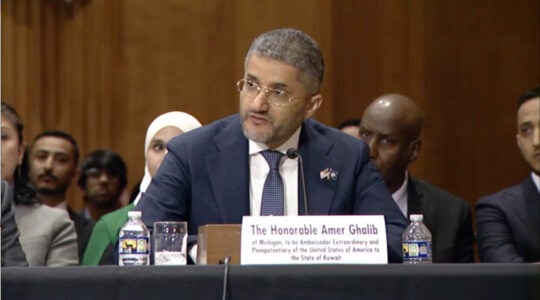LOS ANGELES (JTA) — Ten months after World War I ended, a 30-year-old German army veteran wrote a two-page letter in which he explained the “Jewish question” on a “rational” and “scientific” basis.
“An anti-Semitism based on reason must lead to a systematic combatting and elimination of the privileges of the Jews,” he wrote. “The ultimate objective must be the irrevocable removal of Jews in general.”
Signed “Respectfully, Adolf Hitler,” the letter received high marks for the author from his superiors in a military propaganda unit bitterly opposed to the newly established Weimar Republic as the perceived handiwork of Bolsheviks, Socialists and Jews.
As the first written political statement of the future Fuehrer, the letter is considered a document of immense historical value.
It will be shown to the public for the first time on Oct. 4 by the Simon Wiesenthal Center at its Museum of Tolerance in Los Angeles.
UCLA historian Saul Friedlander, the Pulitzer Prize-winning author of a two-volume analysis of the Nazi regime, observed that “In his very first written statement about the Jews, Hitler shows that [hatred of Jews] was the very core of his political passion.”
At the behest of his superiors, Hitler wrote the letter to a fellow soldier propagandist named Adolf Gemlich, and the document is known as the Gemlich letter. In contrast to his later public rants, Hitler assumes an almost professorial tone in the letter.
For instance, he expounds that “Anti-Semitism is too easily characterized as a mere emotional phenomenon. And yet, this is incorrect. Anti-Semitism as a political movement may not and cannot be defined by emotional impulses, but by recognition of the facts.”
What are the facts? According to the letter, one is that “Jewry is absolutely a race and not a religious association.”
Hitler features the stereotype of the Jew as a money grubber bent on world domination.
“Everything man strives after as a higher goal, be it religion, socialism, democracy, is to the Jew only means to an end, the way to satisfy his lust for gold and domination,” he wrote.
Hitler’s advocacy in the letter of “the irrevocable removal of Jews” has spurred discussions among scholars on whether it anticipates his later extermination campaign.
The German word for “removal” used by Hitler is “Entfernung,” which is more commonly translated as “distance” or “withdrawal.” Taken in context, most experts believe that Hitler’s thinking at the time focused more on “segregation” or “expulsion” rather than a full-fledged Holocaust.
“Not even Hitler was capable of imagining in 1919 what could be done,” British historian Ian Kershaw told The New York Times.
Rabbi Marvin Hier, founder and dean of the Wiesenthal Center, who was instrumental in acquiring the letter and raising $150,000 for its purchase, draws two key deductions from the letter — one historical, the other applicable to our time.
“Apologists for Hitler and Holocaust deniers always cite the fact that no one has found a document signed by Hitler ordering the destruction of European Jewry,” Hier said. “Perhaps such a document was destroyed or Hitler gave his orders verbally.
“In any case, the Gemlich letter proves his obsessive hatred of Jews more clearly than in his later book ‘Mein Kampf’. It is fair to assume that when Hitler wrote about ‘the removal of the Jews’ he wasn’t thinking about just throwing a few thousand Jews in jail.”
The second important lesson Hier draws from the letter is that society cannot afford to ignore or ridicule the demagogues of its day, such as Iran’s president, Mahmoud Ahmadinejad.
“If in 1919, someone had warned that a man like Hitler would become a menace to the world, such a person would have been labeled as crazy,” Hier said.
As part of the permanent exhibit in the museum’s Holocaust section, the letter will be complemented by an interactive timeline tracing the year-by-year spread of Hitler’s power and his ultimate defeat between 1919 and 1945.
The Gemlich letter was found by an American soldier among scattered papers at an apparent Nazi party archive, near Nuremberg. The soldier brought it back to America and decades later the letter came into the hands of a California dealer in historical documents.
When the letter first came on the market in 1988, Hier was skeptical of its authenticity, partly because of numerous instances of forged Nazi documents.
Since then, experts in Germany, Britain and the United States have vetted the letter and have concluded that it is, indeed, the original version, written and signed by Hitler, although 100 percent certainty might require chemical tests of the age and composition of the stationery.
Hier, for one, has no doubt that he has the real thing. “This is the most significant document ever acquired by the Wiesenthal Center, with historical significance not only to the Jewish people, but to the entire world,” he said.
JTA has documented Jewish history in real-time for over a century. Keep our journalism strong by joining us in supporting independent, award-winning reporting.





